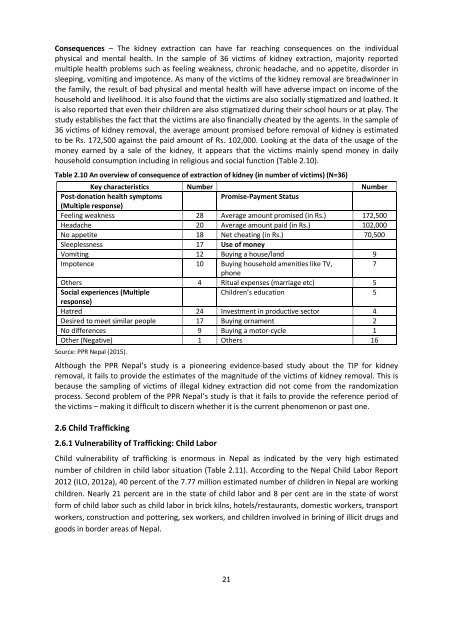TRAFFICKING IN PERSONS
1Spfyta
1Spfyta
You also want an ePaper? Increase the reach of your titles
YUMPU automatically turns print PDFs into web optimized ePapers that Google loves.
Table 2.12 Percentage of married population by age and sex, decennial population censuses, 1961-2011,<br />
Nepal<br />
Census<br />
Male<br />
Female<br />
year<br />
6-9 10-14 15-19 6-9 10-14 15-19<br />
1961 2.97 10.59 35.86 5.29 24.64 71.42<br />
1971 1.20 6.23 26.62 2.33 13.36 60.19<br />
1981 - 14.03 25.09 - 13.36 50.05<br />
1991 - 4.06 19.13 - 7.21 45.5<br />
2001 - 0.76 11.7 - 1.73 33.23<br />
2011 - 0.45 7.05 - 1.12 23.09<br />
Source: CBS, 2014 (Pop Monograph, Vol. 1 Population Dynamics).<br />
Note that the incidence of child/early marriage shows a sharp variation according to rural urban<br />
areas, from one-cultural group to another and from one district to another. Districts with the highest<br />
incidence of child marriage are Bajhang, Baitadi, Dadeldhura, Kapilbastu, Rautahat and Saptari. A<br />
study conducted among 1,200 married women below 24 years of age in these districts revealed that<br />
two-thirds of these women had already married before they attained their 18 th birthday. The<br />
average age at marriage was 16 years (cited in CCWB, 2015).<br />
Given the high magnitude of child marriage, there have been very few complaints registered in<br />
Nepal Police against child marriage. This may be mainly due to cultural acceptance of child marriage<br />
in Nepalese society and partly lack of awareness against child marriage. In FY, 2014/15, there were<br />
23 cases of child marriage registered in Nepal police. Out of these cases, there were 6 cases in<br />
eastern, 4 in central, 12 in mid-western and 1 in far-western development regions (CCWB, 2015).<br />
2.6.3 Vulnerability of Trafficking: Violence against Children<br />
There are several factors that led to vulnerability of trafficking of children, including lack of<br />
education, poverty, dysfunctional family, and occurrence of violence against children in the family<br />
and in the community. Informal Sector Service Center (<strong>IN</strong>SEC) collects and compiles data annually<br />
related with violation of human rights including child rights. In the 2013, a total of 715 children are<br />
reported to have victims of different crimes. Among the crime listed, rape, sexual abuse and child<br />
trafficking are noticeable. Of the 715 crime compiled, rape alone constituted of 57 percent, followed<br />
by sexual abuse (25.5%) and child trafficking (9%). This pattern also holds for the year of 2014 –<br />
suggesting that sexual exploitation, rape and trafficking are the major types of crime against children<br />
in Nepal (Table 2.13).<br />
One important insight from the <strong>IN</strong>SEC data is that there is a wide gap in number of victims of crime<br />
between boys and girls – an overwhelmingly majority of girls compared to boys are at risk of crime.<br />
This happens because almost all the cases of crime of rape, sexual abuse are of girls.<br />
23


